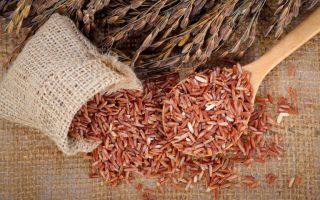Content
- 1 How brown rice is different from ordinary rice
- 2 Chemical composition of brown rice
- 3 Calorie content and glycemic index of brown rice
- 4 The benefits of brown rice for the body
- 5 Healing recipes based on brown rice
- 6 The benefits and harms of brown rice for weight loss
- 7 The use of brown rice in home cosmetology
- 8 Cooking brown rice
- 9 Harm of brown rice
- 10 Contraindications to eating brown rice
- 11 How to choose and store brown rice
- 12 Conclusion
- 13 Reviews
The benefits and harms of brown rice is an interesting topic for those who like to try unusual products in their kitchen. To assess the properties of cereals, you need to understand what its features are.
How brown rice is different from ordinary rice
White and brown rice grains belong to the same cereal. The only difference between the two is processing.
- White grits - these are grains, which are thoroughly cleaned and polished before being packaged and sent for sale. In the process, the husk and germ are removed. Such processing can significantly extend the shelf life of the product and protect against contamination by harmful microorganisms. At the same time, beneficial properties are significantly reduced - cereals lose up to 90% of valuable substances in their composition.
- Brown groats presents itself as grains that have undergone minimal processing and therefore have retained fiber and nutrients almost in full. However, microorganisms and mold damage brown cereals much more often, and besides, rice is very boiled during cooking.
The two types of grains differ in nutritional value. Since brown cereals have more fiber and white cereals are more carbohydrates, brown rice is considered a more dietary product.
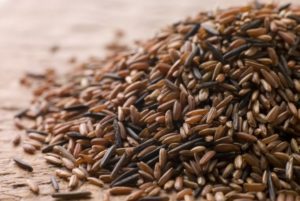
Chemical composition of brown rice
To fully appreciate the benefits of brown cereals after minimal processing, you need to familiarize yourself with the composition of the product. Brown rice contains:
- fiber - it is this component that is preserved in large volumes with minimal processing;
- B vitamins - niacin and pyridoxine, riboflavin and thiamine;
- nicotinic acid PP;
- vitamins E and K;
- vitamin H;
- folic acid;
- magnesium and iron;
- copper and zinc;
- manganese and sodium;
- phosphorus, iodine and selenium.
It is very important to note that brown cereals do not contain gluten - gluten, which often causes allergies in children and adults. Everyone can use it without fear of stomach upset.
Calorie content and glycemic index of brown rice
The calorie content of brown rice is only 362 kcal per 100 g of product - this is the average nutritional value. Basically, the composition of the grain is represented by complex carbohydrates - up to 77.2 g, but also brown rice contains about 7.5 g of proteins and about 1.8 g of fat.
The glycemic index of the product is 45-50 units, which makes it suitable for use in diabetes mellitus - there are no glucose surges from brown rice.
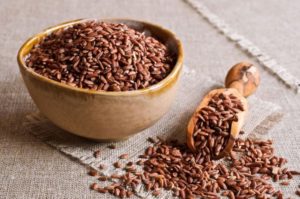
The benefits of brown rice for the body
Brown cereal has a number of health benefits. The benefit of the product lies in the fact that it:
- satisfies hunger well, replenishes energy and has a tonic effect;
- does not contain gluten, therefore ideal for people with gluten intolerance;
- strengthens the nervous system and promotes healthy brain activity;
- has a beneficial effect on blood vessels and improves heart function;
- increases concentration and memory;
- regulates bowel function, has a light fixing effect;
- helps in the work of the liver, promotes the rapid elimination of toxins and toxins from the body;
- serves as the prevention of oncology due to the presence of antioxidants in its composition.
Brown cereal is recommended for people of all ages. But in particular, its benefits are great for the elderly and children, since it rarely causes allergies and has a pronounced positive effect on the body.
Healing recipes based on brown rice
Brown grains are very useful in a constant diet, as they help prevent the development of many ailments. However, the benefits and harms of brown rice for the body are clearly manifested in pre-existing diseases, sometimes the properties of the product are used for treatment.
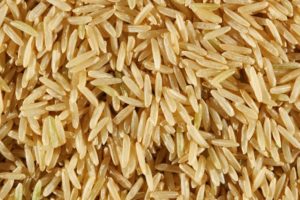
To cleanse the joints from salts
Useful cereals are used to regulate metabolism, remove excess salts from joints and protect bone tissue from arthritis and arthrosis. The following remedy must be prepared:
- a small amount of brown rice is laid out in 5 identical glasses - 2 large spoons of cereal for each;
- the cereal is poured with cold water, the glasses are numbered and they are removed for a day in a dark place;
- after a day, the water from the glasses is carefully drained, and then the cereal is poured with fresh water;
- the procedure is repeated for 5 consecutive days;
- on the 6th day of soaking, rice from the first glass is boiled and taken for breakfast, after which fresh grains are again poured with water;
- on the 7th day, boil and eat rice from the second glass, also soaking a new portion of cereals in the vacated container.
According to the above scheme, a healthy product continues to be taken in the morning for 40 days in a row. During the cleanse, it is important to drink more regular water and eat plenty of vegetables to replenish the loss of potassium in the body. After eating rice infusion in the morning, it is allowed to dine with any food, but not earlier than after 4 hours.
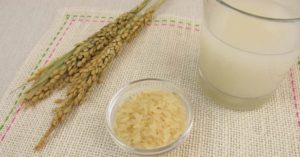
To cleanse the body
The properties of brown rice allow for a general cleansing of the body. To do this, pour 100 g of cereal with a liter of water and boil over low heat for 40 minutes under a closed lid.
Take a decoction of a third of a glass, strained and cooled to a warm temperature, 1 time per day. It is recommended to carry out treatment for 10 days, and then take a break so that there is no harm. The healing agent, when used wisely, will accelerate the metabolism, contribute to the early removal of toxins. This will not only normalize weight indicators, but also improve blood quality, and the liver will experience less stress.
With pancreatitis
During the acute phase of the disease, patients are usually shown hunger - this allows you to quickly relieve inflammation of the pancreas. However, a couple of days after the disease subsides, brown rice can be returned to the diet. In small quantities, when consumed twice a week, the properties of the product will not bring harm, but great benefits, since they will help regulate digestion. In order not to injure the pancreas, the product must first be boiled or even ground in a blender.
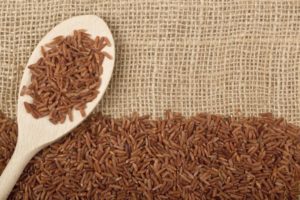
With diabetes mellitus
The benefits and harms of brown rice for diabetics depend on the rate of consumption of the product. Brown grains contain vitamins, folic acid and fiber, so brown rice is very useful for diabetes mellitus - it allows you to keep glucose levels at the desired level.The amount of fast carbohydrates in the product is reduced, and rice does not lead to sharp surges in sugar, but helps to maintain an even state of health.
However, in large quantities, the properties of the product are dangerous for the digestive tract. If there is too much of it, the harm will be expressed in flatulence and bloating, constipation is not excluded. With excessive use of brown rice, you can gain weight, and this will bring unequivocal harm to diabetes.
The benefits and harms of brown rice for weight loss
The benefits of brown unpolished rice are that it is extremely rich in fiber. But, unlike the white variety, it contains little starch, the calorie content of the grains is reduced. All this makes brown cereal ideal for dietary nutrition. When it is used, toxins are rapidly released from the body, and a person quickly loses excess weight. The rice diet has a positive effect on health and appearance, the product gives a good mood and is responsible for the burst of energy.

However, the benefits and harms of brown rice for weight loss are closely related. The product has fixing properties, if eaten too often and too much, it will lead to constipation. Also, the cereal is harmful to people with severe obesity, chronic ailments of the intestines and stomach, diseases of the heart and blood vessels.
Basic principles of the brown rice diet
To maximize the benefits of brown unpolished rice, and the product does not cause harm, it is important to follow several rules on the diet.
- In order to avoid constipation, the product must be combined with fresh or stewed vegetables, salads, herbs.
- The diet may be deficient in vitamins, so it is important to supplement rice with nuts and dried fruits.
- While losing weight, be sure to drink enough water, green and herbal tea. This will help prevent constipation and other gut damage, as well as replenish potassium stores.
- So that the properties of brown rice do not harm, the product should be consumed in an amount of no more than 200 g at a time.
The total duration of the rice diet should be no more than a week. Five- and three-day rice diets are also used.
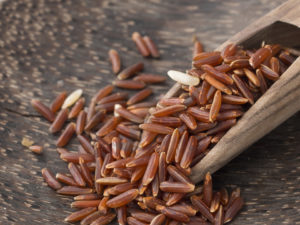
The use of brown rice in home cosmetology
The health benefits of brown rice are used in homemade self-care recipes. Rice benefits both skin and hair - it supplies them with valuable elements and gives strength, has a cleansing and nourishing effect.
Rejuvenating face mask
Using the beneficial properties of brown rice, you can remove fine wrinkles, tighten the skin of the face and make it fresher and more elastic. This requires:
- grind 2 large spoons of rice grains;
- mix with 2 large tablespoons of heavy cream or natural yogurt;
- apply for a quarter of an hour on a previously cleansed face.
It is recommended to do the mask weekly, and preferably twice a week. Then the effect will be noticeable in a month.
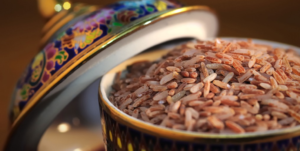
Hair rinse
A homemade brown rice conditioner helps to make curls more manageable, shiny and smooth. A useful remedy is prepared as follows:
- a small handful of rice grains are poured with water;
- insist for several minutes;
- the grains are washed, and then poured with a fresh portion of water;
- insist for another 5 minutes.
After that, filter the water from the resulting infusion and wash the hair along the entire length. 10 minutes after using the rinse, rinse your hair again with clean warm water. With regular use of the product, the curls become softer and acquire additional volume.
Cooking brown rice
Brown rice is quite different from white rice in its structure, it is more rigid and not so easy to heat treatment.Therefore, it is necessary to cook cereals according to a special method so that the beneficial properties of brown rice are fully revealed.
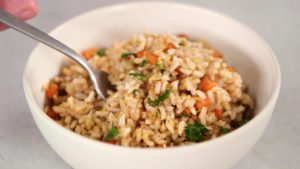
How and how much to cook brown rice
If you prepare a healthy product in compliance with simple rules, then rice will delight you with its softness and pleasant taste with a nutty touch. At the same time, its calorie content will remain very low.
- Before cooking, brown rice must be soaked - and for a long time. The groats are poured with water and kept under the lid for 6 hours or overnight, and then the grains are washed, fresh cold water is poured in and soaked for another half hour.
- First, the cereal is boiled over medium heat for 10 minutes, and then the water is drained from the porridge, poured fresh and boiled for another quarter of an hour.
- The pot with the ready-made porridge is not placed on the table immediately, but first wrapped in a blanket or foil and kept closed for another half hour so that the rice "reaches".
At first glance, it seems that the recipe for making a simple porridge is very troublesome and multi-stage. However, the results are worth the effort. If you boil brown grains in the same way as white grains, then their taste and useful properties will not be appreciated. Moreover, poorly cooked unpolished rice can be harmful, since substances harmful to the human body will remain in its shell.
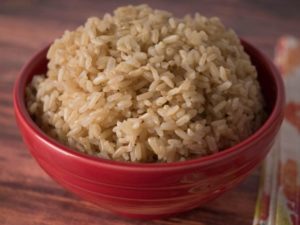
What is brown rice combined with
Brown rice is a product that is suitable for use with a wide variety of dishes. If you wish, you can simply boil a healthy, high-fiber porridge for breakfast. However, the properties of brown rice also appear when applied:
- with fresh vegetables and vegetable side dishes;
- with meat and fish;
- with seafood and egg dishes;
- in soups;
- in stuffed goodies.
Rice can be consumed with fruits and herbs, legumes and many fermented milk products - kefir, yogurt, yogurt, milk. Groats are often found in famous Italian and Asian recipes; brown rice is often used in the same recipes as regular white to enhance the health benefits of dishes.
Harm of brown rice
With its tremendous benefits, brown rice has the potential to be very harmful. This feature is associated with several of its properties.
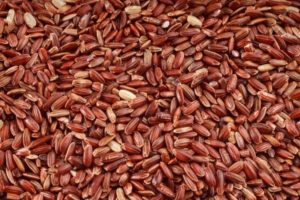
- Rice grains contain poisonous arsenic compounds that are dangerous to human health. There are much more of them in brown rice than in white, since the product is not thoroughly processed. To make rice truly safe, it must be thoroughly washed and boiled, changing the water. Then only beneficial properties will remain in the cereal, and the harm will be eliminated.
- Unprocessed brown rice contains many nutrients and rich moisture reserves. This is precisely its benefit to the body, however, the product suffers more often from microorganisms and fungi. It is necessary to carefully observe the rules for storing brown rice, to prevent the appearance of mold on the surface of the grains. If the cereal begins to give off an unpleasant odor or taste bitter, it should be discarded immediately.
Contraindications to eating brown rice
The health benefits and harms of brown rice depend on the presence or absence of certain ailments. In certain diseases and conditions, it is completely contraindicated. You cannot use the product when:
- allergies to rice grits of any type;
- hypertension, atherosclerosis, heart and vascular ailments - rice aggravates existing diseases and leads to exacerbations;
- urolithiasis;
- gastritis, ulcers and a tendency to flatulence - the properties of rice provoke constipation, bloating and increased gas production.
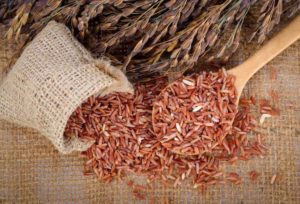
How to choose and store brown rice
Brown rice is growing in popularity and is now available in specialty health food stores and regular supermarkets. When buying, you need to pay attention to several points.
- Rice grains in the package should be approximately the same size and color. The noticeable heterogeneity of the rice indicates its poor quality.
- The shade of quality brown rice is light brown. A color that is too light or too dark indicates that the rice is fake or spoiled.
- The packaging with brown rice should not contain foreign grains of grain, debris and husks.
It must be remembered that brown rice is an extremely healthy and at the same time perishable product. Such features affect its cost - the price of cereals cannot be too low.
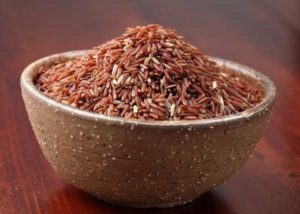
As for storage, it is recommended to keep rice not in an open bag, but in a dry container in a place with good ventilation. The container lid must be tightly closed. Rice can be refrigerated. This will not affect its beneficial properties, but the risk that the product will quickly deteriorate will be lower.
Brown rice should not be kept warm or in an open, sunny place. Under such conditions, the oils in the shell of the grains will begin to oxidize, and the cereals will become unusable. Since rice can absorb odors, it is best to keep it away from other foods.
Conclusion
The benefits and harms of brown rice are a matter of proper storage and preparation of the product. If you correctly boil rice and use it in small portions, then in the absence of contraindications, it will bring undoubted health benefits.

Reviews

